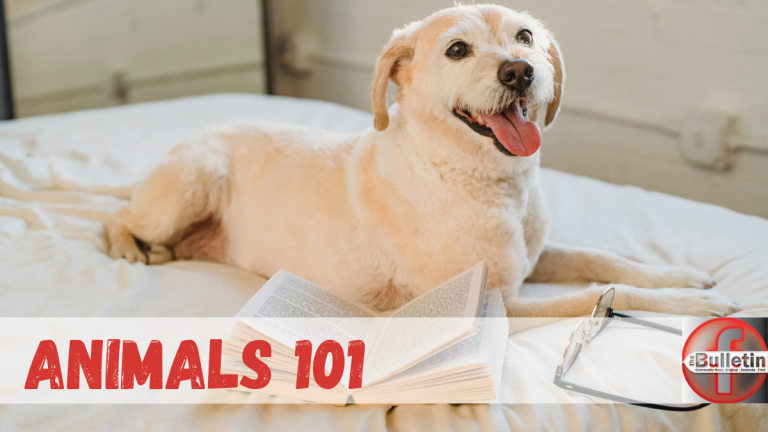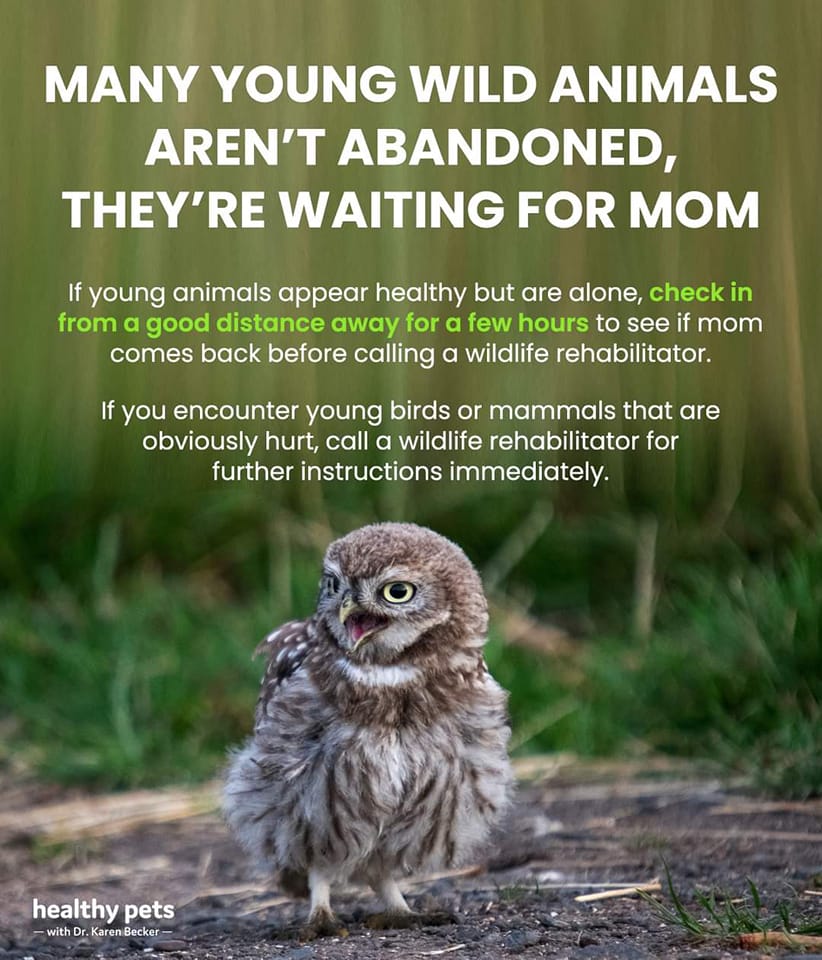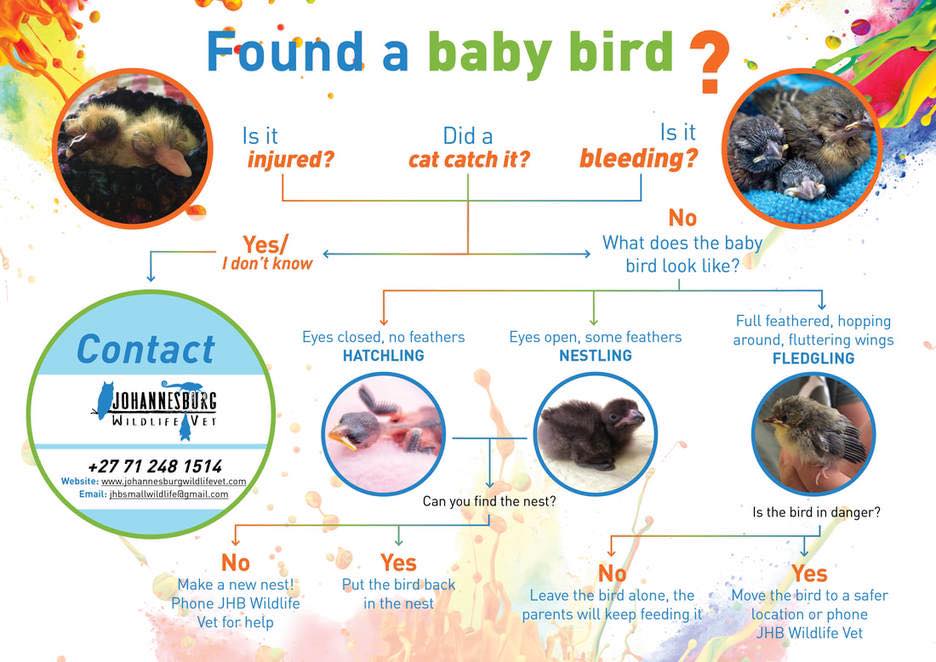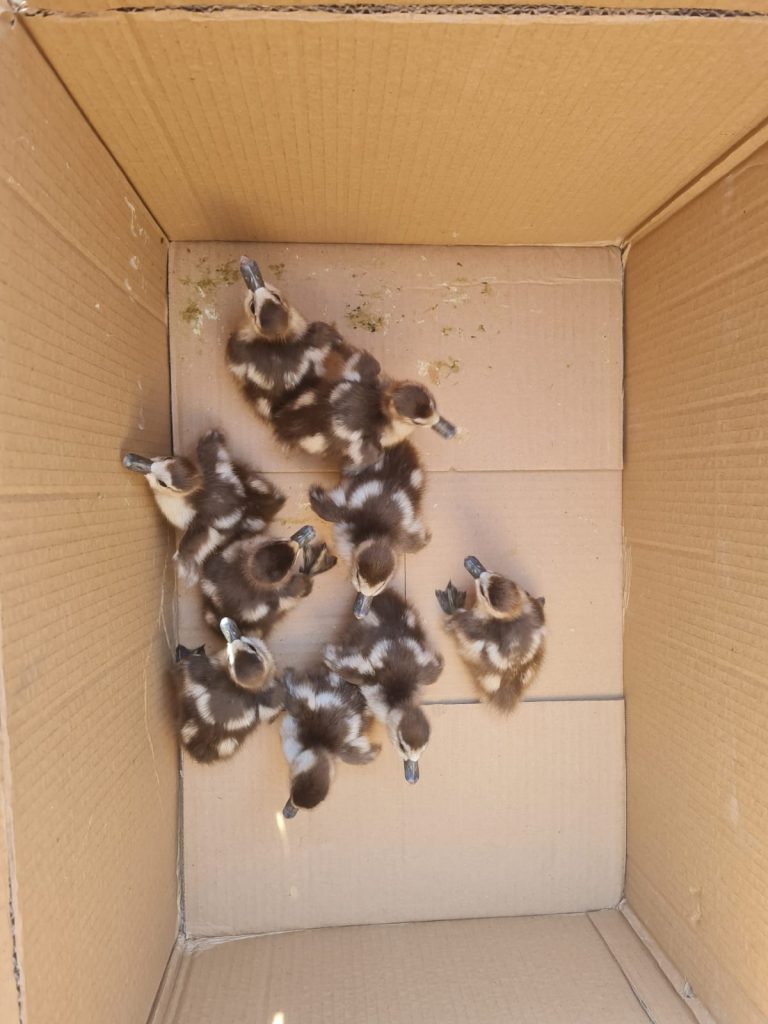
COMPASSIONATE PEOPLE ARE CONCERNED WHEN THEY FIND WILD ANIMALS INCLUDING BIRDS BUT ARE OFTEN UNSURE OF HOW TO HANDLE SITUATIONS.
We have had so many people recently contact us with regards to finding a birds in their gardens. Sometimes wild animals end up around our homes and many people with good intentions try to help them. There is always a possibility that you might do more harm than good if you don’t know how to handle the situation correctly. Today we will focus on finding birds and give some general guidelines shared by the NSPCA and other wildlife rehabilitation organizations.
Sometimes it is a bird/animal that had a stressful encounter and is now just “catching their breath”, other times they might be injured and lost, or is a baby/fledgling. Unless in immediate danger or injured…….let them be. If it is an adult bird (any animal), they might also have babies nearby, which could die if you remove them.
Don’t BIRDNAP the babies! Many young birds may appear abandoned, but they are probably waiting for mom or learning to fly. The process of fledging begins by jumping out of the nest. It usually takes them 3-4 days to learn how to fly. It is the time when mom teaches them how to fear, forage and fly. We know it is a dangerous world, but this is why it is so crucial to learn these skills from mom. If they look a little scruffy, fully feathered, standing and hopping, they are probably a fledgling.

WHAT TO DO IF YOU FOUND WILDLIFE – IN SHORT
1. If they are injured, take them to the vet as soon as possible.
2. If not injured or in immediate danger, let them be and observe.
3. Before you remove them, first contact a wildlife rehabilitator, local welfare organizations, or SPCA to advise.
4. Do not give food or water before speaking to a rehabilitator…..that is why you should contact them as soon as possible. You could kill them by giving them something that their body can’t handle at that moment. You can’t feed a dehydrated bird and the public might not be equipped to know how to recognize the symptoms and they might have an internal injury. For dehydration, they might need liquid therapy too.
Don’t feed them even if it is a tiny baby. Forced syringe feeding is usually a struggle for humans and birds. They can also aspirate, so please do this with the guidance of a rehabilitator only. Many people have this notion to feed Weetbix or ProNutro, but we strongly advise against it. There are safer options if you have to and the rehabilitator will advise on it.
Remember that stress is a big killer of rescued wildlife!

SOME POSSIBILITIES might include (first confirm with the right people):
- To let them be while you look for mom nearby.
- To put the baby back in the nearby nest if you know it is theirs.
- To take them in and keep them safe until the right person can fetch them.
- Get the bird to a wildlife rehabilitator as soon as possible – it will be highly beneficial to the rehabilitators if you keep a record of any injuries you may have noticed when you found the bird as well as any information regarding the treatment of the bird whilst in your care for example whether or not you have given liquids, whether they had any bowel movements, strange behaviour and where you found them.
WHAT TO DO WITH WILDLIFE UNTIL PROFESSIONAL HELP ARRIVES
- Prepare the container. Place newspaper or straw on the bottom of a cardboard box or container with a lid. Don’t use sawdust as it can interfere with respiration.
- If it doesn’t have air holes, make enough for good ventilation. For smaller birds, you can use a paper sack with air holes.
- Protect yourself. Wear gloves, if possible. Some birds may stab with their beaks, slice with their talons (claws) and slap with their wings to protect themselves, even if sick; birds might have parasites (fleas, lice, ticks) and carry diseases.
- Cover the bird with a light sheet or towel.
- Gently pick up the bird and put it into the prepared container-do not hold the bird across its chest as this can damage the crop and the internal organs of the bird which will kill it. Keep the bird in a container; don’t let it loose in your house or car.
- The correct manner of holding a bird is as follows:
Place a hand over the top of the bird very gently with your index finger and middle finger parting in a “V”. The neck of the bird should rest between the arches of the “V” as to stabilize its head and neck. With your other hand support the bottom of the bird and allow its feet to rest comfortably in your hand. Secure the wings of the bird. Do not handle the bird with a tight grip as it just needs to be stable in the above position. Handle firm enough so they don’t escape and get injured, but gently enough not to hurt them yourself. Do not handle them unnecessarily.
- Warm the bird if the weather is cold/wet or if the bird is chilled. Put one end of the container on a heating pad set on low. Alternatively fill a zip-top plastic bag, plastic soft drink bottle with a screw lid, hot water bottle, or rubber glove with hot water; wrap a warm container with a cloth and put it next to the bird. Make sure the container doesn’t leak, or the bird will become wet and chilled.
- If the bird is soaking wet and only if the rehabilitator advised so, use a hair dryer on low/medium warmth to dry the bird. Very important: Keep one hand between the bird and the hairdryer so you can feel the heat. Make sure you do not burn the bird. Ensure there is not a massive build-up of heat in the box while drying. As soon as their feathers are fluffed and the bird is warm, leave it to cool down to room temperature in a quiet area.
- Tape the box shut or roll the top of the bag closed. Obviously not the air holes.
- Keep the bird in a warm, dark, quiet place. Leave the bird alone, don’t bother or handle it. It is stressful for wild animals to be kept in a noisy environment where there are lots of unfamiliar or predator smells and stress is the biggest killer of rescued birds. Keep children and pets away.
- Again, do not give them food or water.
- Contact a wildlife rehabilitator, the SPCA, nature conservation department, or wildlife veterinarian as soon as possible.
- Don’t keep the bird at your home longer than is necessary.
- It would be prudent to leave the bird in the box undisturbed for the evening if it is found late afternoon, unless you’ve picked up an owl, in which case, release them as soon as it is dry so it can hunt, if not injured. Release the animal where you found it, as early in the morning as possible. They start chirping from 4.30 am in the summer months but 5.30 / 6 am would be fine too. Make sure dogs or cats cannot get to them while they are in the box getting their bearings before taking off.
- If you did put water in a small accessible container, make sure the water is not bumped over and the bird then goes without water. Again, this is after you confirmed with a rehabilitator.
- Wash your hands after contact with the bird. Wash anything the bird was in contact with – towel, jacket, blanket, carrier to prevent the spread of diseases and/or parasites to you or your pets.
- If there have been heavy rains or other extreme weather, please take a few extra minutes and check gardens for wildlife that may be drenched and not able to fly.
What happens to the bird afterward? Wild birds need to go back to the wild. If injured, they will need professional help from rehabilitators. It is important to remember that rehabilitators will evaluate each situation individually. Although the above are general guidelines please ALWAYS contact a rehabilitator first.
Also see choosing cruelty-free beauty products and animal testing.
People might also soon be finding grounded bats, especially bat pups too. Read more here on what to do if you find a bat.
BIRD OF PREY
If you found a young bird of prey alone and they appear to not be injured, watch from a distance to see if mom returns. If you can approach the bird, they are likely very sick or seriously injured. If this is the case, follow the above guidelines and contact the vet or rescue organization.
- Do NOT use a wire cage/cat cage or something similar.
- Make note of where the bird was found.
- Do NOT attempt to feed the bird or provide water.
- As above, if it is an owl and not injured, release them at night and don’t keep them for the evening.
GEESE
Common to many areas this time of year, the Egyptian goose population is one of the few on the increase. Egyptian geese lead their goslings to water a few days after hatching, often along busy streets.
“Unlike some of our local wildlife whose existence is being severely threatened by human development and urbanization, our ever-expanding cities and suburbs are proving an ideal breeding site for Egyptian geese. In addition to a warm climate, Egyptian geese look for access to a freshwater source and an area with plentiful food. So, be it your swimming pool, an eco-estate or a golf course, our Egyptian geese are currently spoilt for choice when it comes to sites to rear their young,” says CROW director, Paul Hoyte.
Hoyte suggests leaving the geese be, if they take up residence in gardens, except where there is a danger of attacks from pets. In these cases, he appeals to people to assist them with safe capture.
If you find them in the street, DO NOT “rescue” the goslings or any other little ones by separating them from their parents. You can rather escort the family through the traffic to the nearest pond.
“The biggest problem we have is that to give the goslings the best chance of survival, we need to catch mom and dad too. Herein lies the problem, as they simply fly away as soon as we arrive with our catch and throw nets. Thankfully, what we have been finding as a huge help, is if the homeowner is prepared to lend us a helping hand by getting the family into any enclosed area such as a garage or shed before we arrive”.
“This is relatively easy to do with a washing or laundry basket. Gently scoop up each of the goslings and place them in the basket. Then, with mom and dad watching you, take the goslings and place the basket in your open garage or shed. Soon enough, mom and dad will make their way into the room to be close to their babies. As soon as they’re in, close the door and contact your local rescue to come and catch them.”
Remember: Never feed any ducks or geese bread!

WILDLIFE AND THE SPCA
It is important to understand that it is against the law to keep wild mammals/birds if you don’t have permits, even if you plan to release them. The SPCA is a place of safety for animals, dogs and cats being the most commonly handled or admitted animals and no animal is ever turned away. They care for farm and domestic animals. Wildlife is also accepted with indigenous animals being relocated to approved wildlife rehabilitation centers.
Highveld Ridge SPCA injured stray animals or wildlife at 082 222 1122 / advice 082 869 2350.
Bethal SPCA injured animals 072 573 3122 / advice 066 397 1630
For more advice or if you are unsure of anything contact the South African Wildlife and Rehabilitation centre rescuers.
Judy: 073 112 1131
Leanne: 082 852 2510
Lauren: 082 873 8235
Dirk: 071 755 3791
Stefan 079 771 7125 (in Secunda)
Birds in TEKS area:
Shy 083 653 9755
Willie 079 046 1001
Please be patient when asking for assistance as these rescuers do not only deal with your situation that day. Thank you for caring enough to help. Educate yourself and others on how to help wild and domestic animals in the best possible and safest way. Please consider donating to the organization that assists or takes the animal in.
Next week we will look at the basics of the SPCA Mandate.
WHEN YOU KNOW BETTER, DO BETTER!